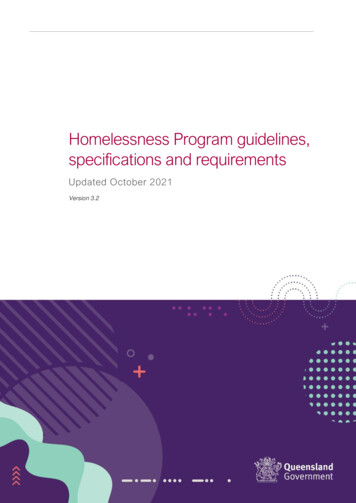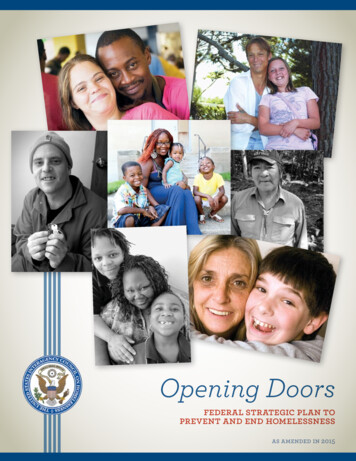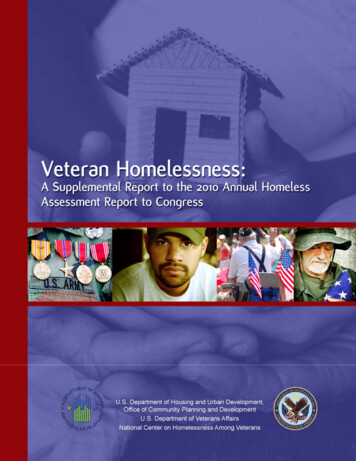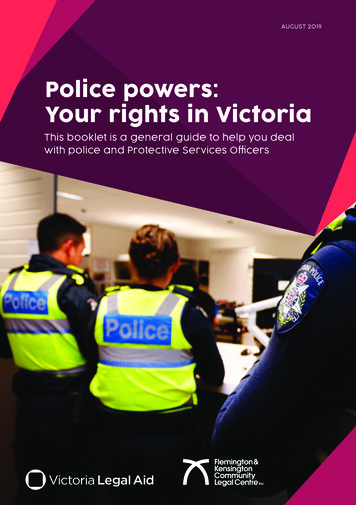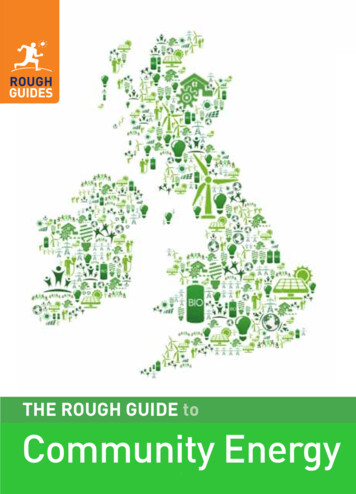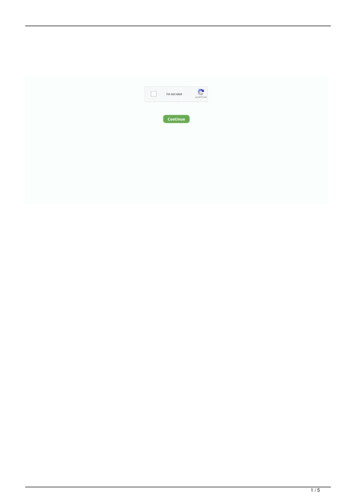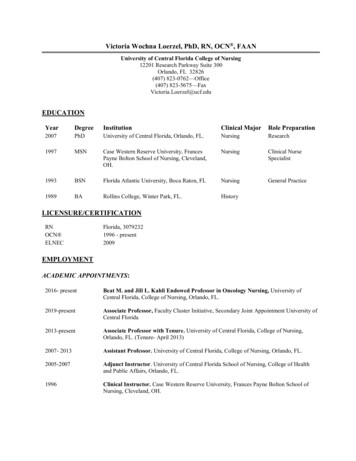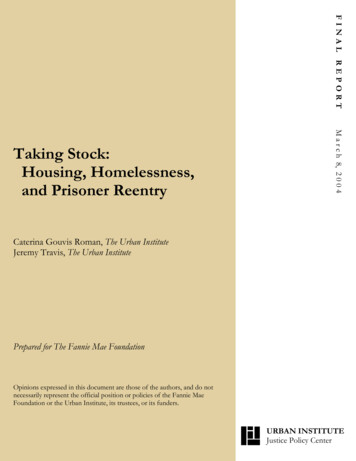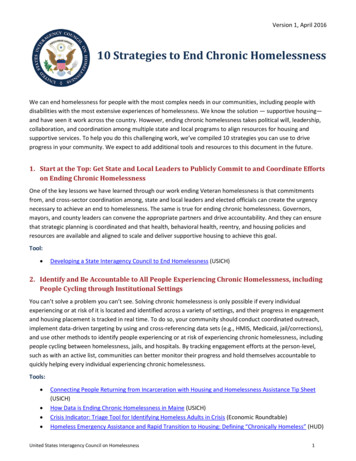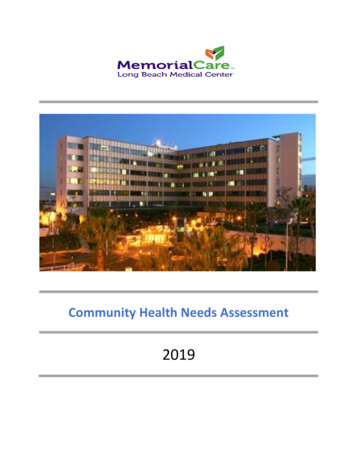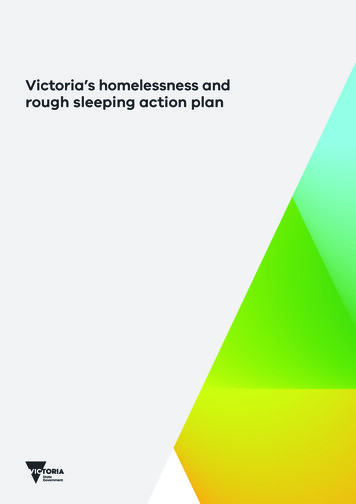
Transcription
Victoria’s homelessness andrough sleeping action plan
To receive this publication in an accessible format,email Homelessness and Accommodation Support haas@dhhs.vic.gov.au Authorised and published by the Victorian Government,1 Treasury Place, Melbourne. State of Victoria, Department of Health and Human Services, January 2018Where the term ‘Aboriginal’ is used it refers to both Aboriginal and Torres StraitIslander people. Indigenous is retained when it is part of the title of a report,program or quotation.ISBN 978-1-76069-208-7 (Print)ISBN 978-1-76069-209-4 (pdf/online)Available at Towards Home www.dhhs.vic.gov.au/towards-home Printed by Waratah Group–Digital, Port Melbourne. (1711047).
Premier’s forewordPeople sleep rough for many different reasons.They might have lost their job, or had animportant relationship break down.They might be the victim of family violence. Orbe dealing with addiction or impairment.Or, perhaps, they just can’t make ends meet.Whatever the cause – and it’s usually more thanjust one – it’s never simple.But the fact is, many Victorians are sleepingrough.If we are to break this cycle of homelessness, we must understand the manydifferent issues at play and be willing to tackle those underlying causes.It’s why we’re increasing and upgrading emergency accommodation, improvingour family violence response, and delivering better mental health care.We’re also making sure that our words are backed up by actions – and funding.Through our 799 million record response to additional housing andhomelessness support, we’re helping more Victorians find the security andsafety of a home.Victoria’s homelessness and rough sleeping action plan represents the nextstep in this work.A long-term strategy to tackle homelessness across our state, the plan providesthe foundations to improve how we partner with communities and agencies,businesses and police, to ensure dedicated support for Victorians experiencinghardship.This work goes beyond government, and beyond arbitrary jurisdictions.Because breaking the cycle of homelessness in Victoria, and minimising thenumber of Victorians sleeping rough, requires many different people andorganisations working together.I would like to thank all those from across the sector, and our state, who gavetheir time and their knowledge to inform this action plan.Their dedicated work will help to provide safety, support, and a brighterfuture for the Victorians who need it the most.The Hon Daniel Andrews MPPremier of Victoria3
Minister’s forewordIn Victoria on any given night there are approximately1,100 people sleeping rough, making up around five percent of the state’s homeless population. Rough sleepingis an unsafe situation for anyone to be in – whetherthat involves sleeping in a car, on the street, in a park,or in a derelict building. It has many complexities thatmultiply over time. Every day, dedicated workers in thehomelessness and allied sectors assist Victorians who arecaught in a deepening spiral of disadvantage from whichit can be difficult to escape without help.This Government is working hard to better support thehomelessness sector to assist people in ways that arebacked by evidence of success. Through our 9.8 million Towards Home package we’veprovided supportive pathways to permanent housing and wellbeing for many of themost vulnerable people who are sleeping rough in the City of Melbourne.This is alongside a 109 million package to prevent homelessness and a 152 millionpackage to provide greater housing options to women and children escaping familyviolence. This includes flexible packages of support and rental brokerage to assistvulnerable Victorians to establish and maintain stable housing in the private market.This is all part of the 2.1 billion in financial backing as part of Homes for Victorians thatwill deliver significantly more social housing stock.Homelessness and rough sleeping are not unique to Victoria. Despite evidence ofrising numbers of people experiencing homelessness across the country, the TurnbullGovernment has pursued savage cuts to welfare and axed the National RentalAffordability Scheme. These cuts must be reversed and the Commonwealth needsto finalise the new National Housing and Homelessness Agreement with states andterritories and return vital funding to the sector.I would like to thank Mr Tony Nicholson of the Brotherhood of St Laurence for hisextensive work to provide me with his advice for a long-term strategy to reduce roughsleeping in Victoria. This complements the work of the Rough Sleeping ResponseTaskforce chaired by Dr Ruth Vine.This action plan is a comprehensive response to rough sleeping and the foundationof the Andrews Labor Government’s long-term strategy to reduce and preventhomelessness. This is about working towards a Victoria where we can all realise ourpotential and everyone has a safe home.Martin Foley MPMinister for Housing, Disability and the Ageing4Victoria’s homelessness and rough sleeping action plan
ContentsPremier’s foreword3Minister’s foreword4Introduction6Intervening early to prevent homelessness13Providing stable accommodation as quickly as possible17Support to maintain stable accommodation21An effective and responsive homelessness service system25Next steps29Victoria’s homelessness and rough sleeping action plan– summary of initiatives305
IntroductionRough sleeping is the most extreme and literal formof homelessness. It includes all kinds of living withoutaccess to conventional dwellings such as sleeping incars, derelict buildings, tents, swags and other typesof improvised shelter.Over the course of a year, many thousands ofVictorians find themselves sleeping rough, includingon city streets and in parks/gardens, carparks,sporting grounds, bushland areas and coastalreserves. Approximately 8,600 people in thesecircumstances seek help from government-fundedspecialist homelessness services.Rough sleeping is a statewide issue. While it is morevisible in Melbourne’s central business district, justas many people are sleeping rough in suburbanMelbourne and country Victoria, where it may alsobe experienced andperceived differently.torian CommunVicitysing StressHouelessnessHomSleepughingRoRough sleeping can be experienced by anyone – single adult men and women,and families with dependent children – with some groups more vulnerable such asAboriginal Victorians, young people, older people and LGBTIQ people. Those whosleep rough are among the most vulnerable and disadvantaged members of thecommunity. They experience a range of harms – such as violence, extreme weatherconditions and poor diet – with lasting impacts on their health and wellbeing thatcan worsen over time.6Victoria’s homelessness and rough sleeping action plan
People can find themselves sleeping rough for many different reasons and for differentperiods of time. Three groups affected by rough sleeping – each with different housingand support needs – are: those who are recently homeless and sleeping rough due to personal crises suchas eviction, job loss, family violence or relationship breakdown – many of whom willsuccessfully resolve their homelessness, either independently, or with the help ofspecialist homelessness services those who have been sleeping rough for an extended period of time (that is, longerthan 12 months) who have multiple related issues – such as mental and physicalillness, alcohol and other drug use issues and past trauma – and are unlikely tosuccessfully negotiate and sustain a pathway out of chronic homelessness withoutintensive resources and ongoing support those at risk of chronic homelessness and rough sleeping following their release ordischarge from institutional settings including prisons, youth justice centres andinpatient health facilities, as well as young people leaving out-of-home care.It is difficult to accurately quantify rough sleeping given it is highly dynamic and oftenhidden. However, the available evidence suggests the number of people sleeping rough inVictoria has increased significantly in recent years.Over the five years to 2016–17, there was a 72 per cent increase in the number of clientssleeping rough when first seeking support from specialist homelessness services. This trendis consistent with a wider increase in homelessness – both in Victoria and nationally – andan associated increase in demand for help. In Victoria, the number of clients assisted byspecialist homelessness services has grown to more than 100,000 each year.Escalating issues have driven the increase in rough sleeping in Victoria, including increasinghousing costs, lack of affordable housing, the inadequacy of Centrelink income support, andfamily violence. Service systems trying to respond to this crisis often don’t have capacityto successfully resolve chronic homelessness or intervene earlier and prevent people fromsleeping rough in the first place.The Victorian Government announced Towards Home in January 2017 – a two-year 9.8million emergency response package to provide housing and support to the growingnumber of people sleeping rough across inner Melbourne.Mr Tony Nicholson, the Executive Director of the Brotherhood of St Laurence, was appointedas Chair of the Rough Sleeping Strategy (the Chair) to oversee the delivery of the TowardsHome package and to develop recommendations for a long-term strategy to reduce roughsleeping in Victoria.In October 2017, following eight months of extensive stakeholder consultation, data analysisand other research, the Chair presented his advice to the Minister for Housing, Disability andthe Ageing, together with a detailed situation appraisal setting out the extensive evidencebase underpinning his recommendations.1This action plan provides the framework for the Victorian Government’s response. Withthe initiatives in this document, we can help more Victorians find the safety and security ofa home.1 Both documents can be viewed or downloaded from the TowardsHome website: https://dhhs.vic.gov.au/towards-home7
The bigger pictureVictoria’s homelessness and rough sleeping action plan buildson the significant reform efforts already underway as part of theVictorian Government’s 799 million investment and 2.1 billion infinancial backing through Homes for Victorians to support the mostvulnerable in our community, create 6,000 new and permanent homesand provide the necessary wrap-around support services for peoplewho are experiencing, or at risk of, homelessness. This includes: the 9.8 million TowardsHome package toprovide housingand support to theincreasing number ofpeople sleeping roughacross inner Melbourne a 109 millionhomelessness packageto assist people whoare homeless or atrisk by interveningearlier to preventhomelessness, improvingresponses to people incrisis and supportingpeople to sustain theirhousing and achieveindependence a 120 million investmentto increase the supply ofsocial housing, includingupgrading of theFlemington Estate, andpartnering with housingassociations to buy andlease 173 more housesacross Victoria a 185 million investmentto upgrade nine low-riseestates, which will delivermodern redevelopedsocial housing a 152 million FamilyViolence Housing Blitzto redevelop refuges,and build and buy morehousing for womenand children escapingfamily violence 33.2 million toextend private rentalbrokerage for afurther two yearsto assist people tosecure and maintainaccommodation inthe private rentalmarket as a long-termhousing option.Through this investment we have acquired, leased or developed486 new units across Victoria to date, while more than 1,800people have been supported to maintain or enter private rentalaccommodation through the Private Rental Assistance Program.A further 472 new or redeveloped units will be delivered in the nearfuture through community-sector led projects to grow the supplyof long-term housing options and upgrades of community-sectorowned rooming houses.8Optional: Document header/footer – can be in document colourOn any given night1,100people sleep roughthroughout Victoriaincluding on citystreets and in parks/gardens, carparks,sporting grounds,bushland areas andcoastal reserves
‘Rough sleeping is a statewide issue’Recentlyhomeless andsleeping rough*Steven’sstorySteven is 47 years old and hasbeen sleeping rough for the pastthree weeks since he left a smallunit, where he had lived for thepast four years. He has neverexperienced homelessness before.Steven was happy in his unit as itfelt like home, however he suffersfrom anxiety and some days didnot feel like he could go to work, sowould call in sick.Eventually this led to Stevenlosing his job, running out ofmoney to pay for his rent andsubsequently being evicted fromthe unit. Steven’s anxiety affectedhis ability to quickly organiseCentrelink payments in time toprevent his eviction. Even oncehe starts receiving the NewstartAllowance, it will not be enough tocover rent and other living costs.Sleeping roughfor an extendedperiod of time*Jen’s storyJen, a 34 year-old women, sleptrough on and off for more thaneight years before she found ahome. In her mid-20s Jen hada partner, a son and stableaccommodation but aftersuffering family violence anddeveloping a substance abuseproblem, everything changedfor her. She had to leave heraccommodation after her sonwas removed from her care andplaced with his grandmother. Jenstarted living on the streets whereshe would sleep in dumpstersbecause she could close them sono one could attack her duringthe night. Jen moved in and outof refuges and even prison justto have a roof over her head. Hermental health deteriorated overthe years and she reported beingat breaking point before shefound help.Specialist homelessness serviceshave been offering supportand accommodation optionsto Steven while he has beenliving on the street for the lastthree weeks. However, he hasbeen reluctant to accept theseoffers due to concerns aboutsharing with other people (suchas a rooming house, sharehouse or crisis supportedaccommodation) and feelingthat there are other people whoneed help more than him.Specialist homelessnessservices will continue to buildtrust with Steven and providepersistent assertive outreach withdedicated case management tohelp him into a suitable form ofaccommodation.Jen was staying at a refuge whenspecialist homelessness serviceshelped her to get back on track byproviding stable accommodationand wrap-around supportservices. She received drugand alcohol counselling,family violence counselling, apsychologist and medication toimprove her mental health. Jenwas provided with a one-bedroomapartment, with her case workersand support services close by. Shereported feeling safe for the firsttime in years and simple thingslike being able to shower andhaving a mail box made a hugedifference in her life. Jen believesthat if it weren’t for her home andher case workers, she wouldn’t behere today.*Names have been changed toprotect identities.9
Victoria’s specialisthomelessness service systemVictoria’s specialist homelessnessservices – funded through acombination of Commonwealthand state government funding ofapproximately 200 million annually– are delivered by a network of 131agencies that collectively provideassistance to more than 100,000 peopleper year.Specialist homelessness servicesinclude assertive outreach, casemanaged support, brokerageand flexible funding to providepersonalised and flexible responses,crisis and transitional accommodation,supportive housing for tenants withcomplex needs and help to enterthe private housing market throughheadleasing and private rentalassistance.Specialist homelessness services areaccessed via 75 entry points across thestate, including specialist entry pointsto assist young people, AboriginalVictorians and women and childrenexperiencing family violence. A full list ofentry points by location is available on theDepartment of Health and Human Serviceswebsite at www.services.dhhs.vic.gov.au/getting-help. Complementing face-toface services, two statewide phone lines– for people in housing or family violencecrisis – operate around the clock, linking tothe local entry points, so that people canaccess assistance whenever and whereverthey need it.However, with a growing number of peoplefacing homelessness across Victoria,demand for specialist homelessnessservices continues to grow. This is placingsignificant pressure on the system –particularly at the crisis intervention end –and highlighting a range of service gaps.As identified by the Chair, the specialisthomelessness service system strugglesto provide a permanent housing outcomefor people who are sleeping rough –particularly for those experiencing chronichomelessness. This is due to a shortage ofsuitable housing in which clients can beplaced as well as the limited support thatcan be offered to clients once housed.The currentsystem strugglesto provide a permanenthousing outcome,particularly for peopleexperiencing chronichomelessness andrough sleepingFigure 1 Challenges with thecurrent service ingroughThere is a lackof early interventionto stop the flowof people intohomelessness andrough sleeping10Victoria’s homelessness and rough sleeping action planIntemporaryhousingInMaintainingpermanent permanenthousinghousingThere is a shortageof stock to enablerapid access tosuitable, affordable,permanent housingSupport offered isnot at requiredduration and intensityto meet the needs ofpeople experiencingchronic homelessness
The action planVictoria’s homelessness and rough sleeping action plan represents theVictorian Government’s response to the Chair’s recommendations and is thefirst phase of a broader reform of the specialist homelessness service system.Informed by the advice of the Chair, the action plan provides a framework forreducing the incidence and impacts of rough sleeping within the context offour key themes guiding broader homelessness reforms in Victoria:Figure 2: Four themes guiding homelessness reformsIntervening early toprevent homelessnessProviding stable accommodationas quickly as possibleSupport to maintainstable accommodationAn effective and responsivehomelessness service systemThe action plan also focuses on the three distinct groups of people affected by roughsleeping – (a) those who are recently homeless and sleeping rough, (b) those who havebeen sleeping rough for an extended period of time and (c) those at risk of chronichomelessness and rough sleeping – to ensure that our responses are tailored to meetthe differing housing and support needs of each.Significantly, the action plan progresses the reform of Victoria’s specialist homelessnessservice system, building on current strengths and moving towards prevention and earlyintervention. This includes investing in approaches that better meet the needs of thoseexperiencing chronic homelessness, who have not been served well by the social servicessystem to date. The action plan outlines a suite of initiatives to be delivered over the nextfour years aligned with the four homelessness reform themes. It also includes a numberof future directions to build on these initiatives over the medium to longer term.The framework underpinning the action plan, which illustrates the different housing andsupport needs of the three rough sleeping cohorts, is illustrated in Figure 1 on page 10.11
Figure 3: Overview of Victoria’s Homelessnessand Rough Sleeping Action PlanRough sleeping cohortsRecently homelessand sleepingroughIntervene early to resolverough sleeping quicklyAssertiveoutreachto find andengageInterveningearly to preventhomelessnessProviding stableaccommodation asquickly as possibleSupport tomaintain stableaccommodationSleeping roughfor an extendedperiod of timeResolve chronichomelessness and preventfuture recurrenceAt risk of chronichomelessness andrough sleepingPrevent homelessness/roughsleeping on release/dischargeand reduce future riskProactivereferral byalliedservicesRapidrehousing(for exampleprivate rental)Routineassessmentof riskAssertiveoutreachto engageManagedpathway t(for exampleflexible supportpackages)Intensiveongoing support(for examplesupportivehousing teams)FlexiblesupportManagedpathway topermanenthousingServices are:AccessibleAn effectiveand responsivehomelessnessservice system12EvidencebasedVictoria’s homelessness and rough sleeping action planCoordinatedClient-centredOutcomesfocused
Interveningearly to preventhomelessnessRough sleeping exposes people to a range of harms –including violence and extreme weather conditions– with lasting impacts on both their physical andmental health and their capacity for social andeconomic participation.Rough sleeping reduces life expectancy, and in the most catastrophiccircumstances, it directly results in death. Although many people sleep rough foronly a short time, the longer a person remains without shelter, the more seriousthe effects on their health and wellbeing become and the more difficult it is tosuccessfully resolve their homelessness.To reduce the incidence and impacts of rough sleeping in Victoria, we muststop the flow of people into homelessness. This requires prevention across theVictorian community aimed at the causes of homelessness and rough sleeping– such as housing stress and family violence – as well as early intervention withthose who are recently homeless and sleeping rough or who are at risk.13
In his advice to the Minister for Housing, theChair identified two priority areas for preventionand early intervention: (a) locations beyondcentral Melbourne where many people firstexperience crisis leading to homelessness andrough sleeping and (b) justice, health and humanservice systems that have contact with peoplewho are at greater risk of homelessness andrough sleeping.Ultimately, we need to find, engage and assistpeople who are sleeping rough more rapidlyto prevent any escalation of their situationand minimise risk of harm. This includes alliedservices – such as jobactive employmentassistance providers – proactively referringtheir clients who are sleeping rough to specialisthomelessness services for assistance. We mustalso ensure that we routinely assess people’srisk of homelessness prior to their releaseor discharge from settings that are knownpathways to rough sleeping – including prisons,youth justice centres, inpatient health facilitiesand out-of-home care – and provide suitablehousing and support to those who need it.What are we currently doing?Expanding assertive outreach servicesAssertive outreach is the most effective way tofind and engage people who are sleeping rough.We have provided 1.1 million for additionalassertive outreach services through the RoughSleepers Initiative and Melbourne Street toHome. With the additional capacity in the City ofMelbourne, assertive outreach teams are activelyengaging with around 50 rough sleepers in thecentral business district each month includingmany people who have been sleeping rough foran extended period of time. Through persistentengagement and mobile assessment, theseresponses have assisted more than 185 peopleinto temporary or permanent accommodationsince January 2017.Extending homelessness assessment andplanning capacity across Victoria’s prisonsystemRoutine assessment combined with pre-releaseplanning for housing and support can preventpeople in prison from exiting into homelessnessand rough sleeping.We have provided 5.5 million to expandhomelessness assessment and planning servicesacross Victoria’s adult prison system to ensurepeople are provided with housing informationand support, including referral to specialisthomelessness services before they exit prison.This is delivering additional coverage acrossboth men’s and women’s prisons, including tothe increased number of people on remand – asignificant driver of demand.We will also trial an enhanced model providingtargeted intensive support and case coordinationto assist people to access and maintain housingpost release.14Victoria’s homelessness and rough sleeping action plan
Supporting young people leaving out-ofhome care or the youth justice systemIntervening early by providing housing tovulnerable young people as they leave out-ofhome care is vital. It can decrease their risk ofexperiencing chronic homelessness and increasetheir opportunities to find a job or continue theireducation.At the same time, we also need to ensure thatyoung people leaving the justice system haveaccess to appropriate case management, so thatthey do not return to rough sleeping, or reoffend.We have provided 10.1 million to design and testnew medium-term housing options for vulnerableyoung people. This includes board payments,housing subsidies and leasing arrangements untilthe age of 21. These will be targeted at areas ofhighest need including regions with large numbersof out-of-home care leavers combined with highcost housing.Complementing this, we are working with aconsortium led by Anglicare Victoria to develop aSocial Impact Bond to deliver improved outcomesfor young people leaving out-of-home care. Thetwo year program will provide individualised casemanagement, specialist support and safe andsecure housing to enable young people to developthe independent living skills they will need as adults.What will we do to build on this?Establish assertive outreach teams insuburban, regional and rural areasDespite the relatively even distribution ofpeople sleeping rough across the state, thereare currently few assertive outreach servicesoperating beyond inner Melbourne.Port Phillip and to establish eight new assertiveoutreach teams with dedicated brokeragefunds in the areas of highest incidence of roughsleeping throughout the state – three outersuburban and five regional/rural locations.These are Dandenong, Frankston, Maroondah,Geelong, Swan Hill, Warrnambool, Ballarat andBendigo. Each team will have the capacity toprovide assertive outreach to up to 120 peoplesleeping rough each year, including rapid accessto emergency accommodation, health services,ongoing case management and housing support.Lobby the Commonwealth Governmentregarding levels of income supportAn adequate level of household income isessential to both accessing housing and avoidinghousing stress and subsequent housing loss thatcan lead to homelessness and rough sleeping.Once people are sleeping rough, many loseaccess to income support due to their difficulty inmeeting Centrelink requirements.We will continue to highlight the impact ofinadequate levels of Commonwealth incomesupport on Victorians struggling with housingaffordability and the cost of living. We will alsowork with the Commonwealth Governmentregarding the provision of flexible, individualisedemployment assistance services for Victorianswho are sleeping rough.We will provide 19 million to extend the RoughSleepers Initiative to the City of Yarra and City of15
What will we do in the future?Explore ways to provide people who aresleeping rough with more immediateaccess to helpPeople who are recently homeless and sleepingrough are often unaware of how to access help.We will explore ways to harness differenttechnologies as a means of providing peoplewho are sleeping rough with more immediateaccess to services, including after-hours. As partof this work, we will also examine ways in whichto acknowledge and engage public concern forpeople who are vulnerable and sleeping rough.Work with allied services regarding clientreferrals to specialist homelessnessservicesAllied services such as jobactive employmentassistance providers may be ‘first to know’ thata client is recently homeless and sleeping rough.As such, through timely proactive referral tospecialist homelessness services, these providershave a key role to play in facilitating earlyintervention.We will canvass opportunities to improve referralprocesses to ensure that people are referred tospecialist homelessness services at the earliestopportunity.Expand early intervention initiativestargeting people exiting settings that areknown pathways to rough sleepingThrough routine screening coupled with dedicatedpathways to housing and support, we can preventpeople being released or discharged from settingssuch as prisons, youth justice centres, inpatienthealth facilities and out-of-home care intohomelessness and rough sleeping.We will continue to build on current reforms suchas the expansion of assessment and planning inprisons to lead to sustainable housing outcomesand the development of dedicated housingoptions for young people leaving out-of-homecare or the youth justice system to bolsterearly intervention for those at risk of chronichomelessness and rough sleeping.Future directionsIn the context of the broader reform of thespecialist homelessness service system, wewill intervene earlier and more rapidly toprevent homelessness and rough sleeping,or minimise the duration or impact ofhomelessness when it occurs. We will lookat ways to achieve this by: providing support and assistance totenants in private rental to avoid housingbreakdowns and evictions prioritising those most vulnerable tohomelessness including people exitinginstitutions assist people to avoid homelessnessby providing more flexibility in the wayfunding is used to meet their needs improving our partnerships withagencies who are often ‘first to know’when people are at risk of homelessness.16Victoria’s homelessness and rough sleeping action plan
Providing stableaccommodation asquickly as possibleRough sleeping cannot be resolved withouthousing. There are many different pathways intohomelessness and rough sleeping, yet all peoplesleeping rough share the same fundamental need forhousing. Housing provides an essential foundationfrom which to build a healthy and productive life.For people who have been sleeping rough, housing not only prevents furtherharm and deterioration in health and wellbeing, but also offers a safe and stablebasis f
This action plan is a comprehensive response to rough sleeping and the foundation of the Andrews Labor Government's long-term strategy to reduce and prevent homelessness. This is about working towards a Victoria where we can all realise our potential and everyone has a safe home. Martin Foley MP Minister for Housing, Disability and the Ageing

